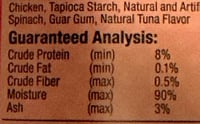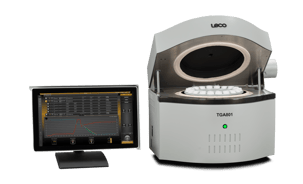 Unlike the detailed list of nutritional requirements for human food, pet food in North America must only report on four main values in their Guaranteed Analysis on the label: protein, fat, fiber, and moisture. Additional nutrients must be included if they are called out specifically on the label, but manufacturers can also voluntarily add more nutrients to provide consumers with more information or further demonstrate the nutritional value of their products. One voluntary "nutrient" that shows up with surprising frequency in these lists is actually "Ash". But ash in the analysis doesn't actually mean ash is in the food. Rather, it explains the process by which mineral content is determined.
Unlike the detailed list of nutritional requirements for human food, pet food in North America must only report on four main values in their Guaranteed Analysis on the label: protein, fat, fiber, and moisture. Additional nutrients must be included if they are called out specifically on the label, but manufacturers can also voluntarily add more nutrients to provide consumers with more information or further demonstrate the nutritional value of their products. One voluntary "nutrient" that shows up with surprising frequency in these lists is actually "Ash". But ash in the analysis doesn't actually mean ash is in the food. Rather, it explains the process by which mineral content is determined.
 Mineral content in pet food – calcium, iron, zinc, phosphorus, etc. – does not burn, while all other materials – fat, protein, fiber, etc. – does. A fast way to test for the general mineral content is to take a sample of food, weigh it, burn it until it is no longer losing mass, and then weighing it again. Whatever is left – the ash – is the mineral content and this can be reported to regulators or put on a label.
Mineral content in pet food – calcium, iron, zinc, phosphorus, etc. – does not burn, while all other materials – fat, protein, fiber, etc. – does. A fast way to test for the general mineral content is to take a sample of food, weigh it, burn it until it is no longer losing mass, and then weighing it again. Whatever is left – the ash – is the mineral content and this can be reported to regulators or put on a label.
As Michael Jakob discusses in a recent Feed & Additive article, mass loss on ignition/combustion with an air oven or a muffle furnace is one of the most common methods to determine ash content. Similar methods, at lower temperatures, can be used to determine moisture in food samples, which is another value important for labels and regulation. This sort of thermogravimetric analysis is widely accepted for food and feed analysis in laboratories around the world.
This process is usually quite lengthy and labor-intensive. Samples must be measured and recorded at multiple stages, with care taken not to introduce atmospheric contamination throughout the process. Since the analysis concludes when the weight remains consistently constant, they are usually run for multiple hours to ensure the sample is ready, which often wastes both time and energy. Many automated thermogravimetric analyzers are small, only able to handle one or two samples at a time, which can lead to what feels like an endless cycle of going round and round.
 LECO's TGA801 takes the never-ending circle out of your cycle with its macro thermogravimetric analysis. An automated carousel can handle 19 samples of up to 5 g simultaneously, determining both moisture and ash in a single run to maximize efficiency, analysis time, and sample batch throughput. The operator only needs to select the method and log in the initial sample weights. Once the oven is closed, everything else is handled within the TGA801’s system.
LECO's TGA801 takes the never-ending circle out of your cycle with its macro thermogravimetric analysis. An automated carousel can handle 19 samples of up to 5 g simultaneously, determining both moisture and ash in a single run to maximize efficiency, analysis time, and sample batch throughput. The operator only needs to select the method and log in the initial sample weights. Once the oven is closed, everything else is handled within the TGA801’s system.
Throughout the analysis sequence, the sample carousel moves each crucible sequentially onto the integrated balance pedestal for a continuous monitoring of the weight, recording all measurements. Once all the samples show the weight constancy for moisture, the instrument can automatically ramp up the temperature for the ash determination, handling weight constancy in the same way. The analysis will end precisely when weight constancy for the final step has been achieved, saving time, money, and uncertainty. During this process, the operator is able to walk away from their instrument and focus on other tasks, with CORNERSTONE® Mobile, our mobile software link to LECO instruments, able to alert at cycle completion or if any problems arise.
Fill out the form below to read an app note on moisture and ash determination in animal feed with the TGA801. Still not sure? Sign up for an upcoming webinar featuring a live demonstration of the TGA801 in action to see what you've been missing.

